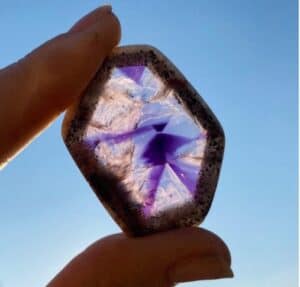Trapiche gemstones have an allure that satisfies the human desire for symmetry. These unusual-looking stones exhibit a wooden milling wheel used for processing sugar cane and that is where the name is derived from.
The geological conditions necessary to create these patterns in precious and semi-precious gemstones are uncommon which puts Trapiches in the rare gemstone category. Their relatively recent discovery has provided very little information about how they’re formed and their commercial availability is limited.
In this article, you’ll learn some of the basic facts about Trapiche gemstones, their different varieties, and the identifying characteristics of each one.

What Are Trapiche Gemstones?
Trapiche gemstones should not be confused with gemstones displaying asterism, for example, a star sapphire or a star ruby. These rare stones form with a radiating star of inclusions between their growth sectors. While some form with a hub or core containing spokes radiating outward from the core, others include spokes from the center of the gemstone. Only minerals containing highly symmetric crystal habits are known to form the arms or spokes that define these gemstones. Additionally, genuine Trapiche stones have inclusions of organic matter.
That said, simple color-zoning or inclusion growth within crystals can create a Trapiche-like pattern. True Trapiche minerals are broken into defined sections with the main gemstone taking up the largest section and the mineral or organic inclusions creating the individual spokes.
The same minerals that form true Trapiches may form Trapiche-like color zoning. For instance, rutilated quartz displays a stunning patterned inclusion but don’t confuse these with True Trapiche.
List of Trapiche Gemstones
Trapiche emeralds are among the best-known examples of these rare gems and were discovered by Emile Bertrand in 1879. It came from the world-renowned Muzo mine in Muzo, Columbia.
Over a century after the first description of Trapiches, in 1995, Trapiche rubies were reported to be found in Mong Hsu, Myanmar. A year later, Trapiche sapphires landed on the market. Since the late 90s, gemological laboratories have confirmed several Trapiche specimens, including garnet, spinel, tourmaline, quartz, and aquamarine.

Trapiche Ruby
Trapcieh rubies have been found in Southeast Asia and display a six-rayed star pattern similar in effect to Trapiche emeralds. They are comprised of six transparent-to-translucent Ruby sectors separated by nontransparent white or yellow planes.
A perfect Trapiche ruby will have hexagonal tapered red, yellow, or black cores and tube-like inclusions in the white or yellow arms of the star and in the boundary zones between the cores and the six ruby sectors. The inclusions of Trapiche rubies are oriented perpendicular to the morphologically dominant dipyramidal crystal faces.

Trapiche Amethyst
One thing that distinguishes Trapiche amethysts from other types of amethysts is the pinwheel pattern caused by the inclusions which should have a starfish shape in the center of the stones. If it’s type A, the shape will be caused by mineral inclusions, and if it’s type B the starfish shape is made by amethyst.
Because Trapiche gemstones are so rare and valuable, many sellers are creating fake patterns using dye or other methods. However, it’s relatively easy to spot fakes if you know what you’re looking for. The pinwheel in fake Trapiche usually looks like someone took a black permanent marker and colored directly on the stone.

Trapiche Sapphire
Trapiche sapphires typically have a dark blue body color that’s translucent to opaque. The core of some crystals seemed colorless, while others showed slight hints of a very light blue. The Trapiche pattern in sapphires is often expressed as hexagonal cores with six radiating arms or spokes. White reflective features stand out against the dark blue color of the crystal’s body.
What Causes Trapiche In Gemstones?
True Trapiches form where geothermal waters meet carbonaceous host rocks. The fluids are chock full of chemicals that lead to gem formations that cause seed crystals to form. Then a type of color zoning occurs during the mineral growth. The gems will cease growing along the rough outer edges of the crystal and instead will grow only along the smooth faces. This, in turn, leads to the equivalent growth faces that authentic Trapiche gemstones display.
When the gemstone materials grow on the mineral faces with arms of carbonaceous inclusions, it’s a type A or standard sample. Exceptionally rare Trapiche specimens of type B or reverse varieties can also occur. In type B specimens, the gem material itself forms the spokes or arms, as in the example of Trapiche amethyst.
- Identify Enstatite - March 12, 2024
- Identify Cerussite - March 3, 2024
- Identify Bytownite - February 18, 2024
